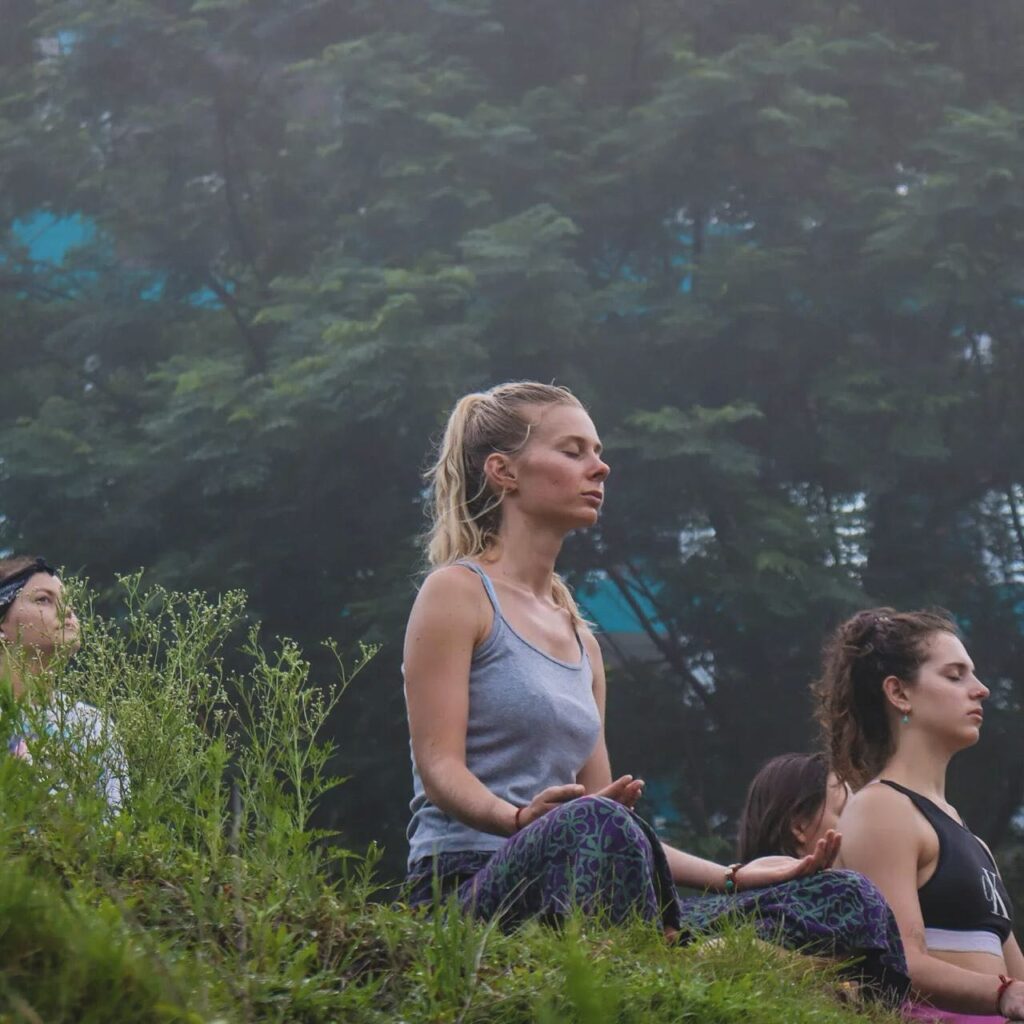
The 8 Limbs of Yoga: A Holistic Path to Inner Peace, Clarity, and Spiritual Growth
Ever have that feeling when life is a mad rush to another to-do and constantly in the chase of the next big thing? You don’t stand alone. The modern world is fast-paced, and it is easy to get caught up in the external to-do lists at work, the pressure to succeed, and a ton of changes coming in every stream of information.
But what about the internal?
What about that inner voice that truly begs for quiet, clarity, and a vision of meaning?
This is where yoga’s ancient knowledge comes into action. More than mere asanas, yoga is a holistic well-being approach that incorporates body, mind, and spirit. At the very core of this philosophy lies the fundamental tenet of the 8 Limbs of Yoga, an elaborate scheme explained in the Yoga Sutras of Patanjali.
In this blog, we will learn the importance of these 8 limbs, from moral rectitude (Yama) and self-control (Niyama) to physical postures (Asana) and meditation (Dhyana) in guiding inner change. We will also discuss how these ideas have been applied to our school’s activities, providing a unique mix of traditional teaching and innovative use.
So, if you are ever ready to get off the treadmill of life and find a place for deep peace, clarity, and connection, then align with us to know the 8 Limbs of Yoga to bring forth a practical transformation in your life with an age-old wisdom rooted within them.
- Yama: Ethical Restraints
Life leads us to the stages of yoga through Yama—the set of five ethical restraints that describe the way we spend our lives in relation to the exterior world. Think about Yama as the cornerstone on which the whole structure of yoga practice stands. It is about bringing inner peace through harmonizing our actions with principles of kindness, honesty, fairness, and respect; it is about living life with a heart that goes well to these moral principles. Let us explore all these steps:
- Ahimsa: non-violence. Ahimsa is more than just stopping from doing any harm physically. Ahimsa is promoting deep love and kindness for all beings, including our own. This means caring for our well-being, our areas of weakness where we are prone to self-critical feelings, and extending kindness and understanding to others—even when they’re not on our side.
In practice, this could mean offering a helping hand to someone in need, engaging in gentle and respectful communication, choosing to remain vegetarian or vegan, and avoiding gossip or spreading negativity.
- Satya: truthfulness. Satya is the Hindi translation for honesty and integrity. Align our thoughts, words, and actions to be true to ourselves and others. This might not mean revealing all thoughts or opinions all the time, but rather developing a pure and spontaneous longing for all things authentic, without deception or manipulation.
In practice, it could mean speaking your truth kindly with respect and keeping promises, being aware of places in which you deceive yourself and others.
- Asteya (Non-stealing): Asteya means respecting others’ belongings and not taking them or extracting more than one’s fair share and helping others. This also runs beyond the physical sense to include respect for people’s time, energy, and intellectual property.
In practice: Generally speaking, it can involve being aware of one’s own consumption habits; someone who supports sustainable and ethical firms would typically respect the boundaries of others in many ways.
- Brahmacharya (Moderation): Oftentimes, Brahmacharya is misunderstood as celibacy. More broadly, this means moderation in all forms of life, including eating, sleeping, postsensitive searching, etc. It involves finding the balance in one’s life and avoiding excessiveness in any area.
In practice: In practice, this could invite practices of mindful eating and setting healthy boundaries with technology, bringing awareness back to your sensory experiences.
- Aparigraha (Non-possessiveness): In a world obsessed with accumulation, Aparigraha urges us to consciously cultivate contentment—a detachment from worldly possessions. It is the realization that genuine happiness is based upon one’s own choices, that this internal happiness cannot be gained through external means.
In practice: Think of decluttering one’s life or being thankful for what’s owned, possibly supporting charitable organizations.
A more peaceful and satisfying existence for oneself and others can be achieved using the conscious development of these moral boundaries. It is to keep in mind that Yama is a continuous practice, a path of self-awareness and improvement.
2, Niyama: Observances and Self-Discipline
The Niyama comes with the fundamentals established by personal observations and self-determined disciplines if Yama compromises on the universal ethical foundations. The internal practices that nourish and renew from the inside out are known as the five Niyamas.
- Saucha (Purity): Purity doesn’t stop with physical cleanliness; this is where purity does address physical, mental, and emotional. You can say you create a clean, clear area within yourself, so your spirit can thrive.
Act one: Commitment to self-hygiene practices, practices around the diet, nurturing healthy habits such as physical exercise and sleep, and maintaining a clean, livable space. Also, practices around mindful speech language, rejecting negativity, and nourishing thoughts.
- Santosha (Contentment): In this world of stubborn superficiality on every side, Santosha seems a radical act of rebellion. It is all about equal and contented acceptance of “what is,” instead of an endless chase for “what could be.” It is enjoying the moment that is present, taking delight in simple things, and realizing the abundance in your life that already exists.
In practice: This may include an act of thanksgiving, living in the moment, and being happy in life’s most minor pleasures. When feelings of dissatisfaction arise, try to identify the root cause and address it accordingly, gently and with an understanding heart.
- Tapas (Austerity): Tapas is the spirit of inner discipline, restraining the things you love; this does not mean punishing yourself.It’s a healthy approach to disrupting your routine, be it the point of focus yoga practice, mindful eating, or other areas of your life. It’s about cultivating the inner strength and resilience to overcome difficulties and lessons from them.
Tapping can be practiced by defining small goals and accomplishing them, exercising daily discipline, and slowly moving out of the comfort zone in a manner that nurtures and supports.
- Svadhyaya (Self-study): Self-study means looking deep within yourself, going deeper and deeper into the heart of your being. It is a practice of retrospective self-reflection, self-examination, study of wisdom teachings, and asking the heavy questions of life. It lends to deepening understanding of self, of values, and of place in the world.
In practice, it could mean journaling, meditating, getting inspired reading, engaging in deep conversations, or going on nature walks.
- Isvara Pranidhana (Surrender to the Divine): Surrender doesn’t mean agreeing to give your will to a deity. It refers to a leap of faith or trust in the higher power, be it the universe, your intuition, or some governing principle. It is letting go of control and allowing some power greater than yourself to guide you.
In practice: This could involve spending time in nature, practicing mindfulness, performing acts of service, and believing in the unfolding of life.
It is through Niyama that we consciously build a strong internal foundation for our yoga practice and train ourselves for life. Letting go of the quest for perfection, these techniques are designed for sincere effort that is filled with gentleness and compassion toward self-transformation.
3. Asana: Physical Postures

Asana is the next step we will take into the bodily aspect of yoga. It literally translates to mean “comfortable seat” or “posture.” While often brought to mind in conjunction with more recognized yoga poses, asana refers often to much more than body stretching or toning.
Benefits for the Body:
- It keeps various muscle groups toned and strengthened as well as flexible, with a highly developed range of motion and balance. It enhances circulation and immunity, thereby supporting the proper curvature of the spine.
- The Benefits for the Mind and Emotions: Beyond the physical, asana cultivates body awareness and mindfulness. Moving through postures could calm the mind down and help lessen stress and focus with an unclouded, discriminating mind. While working on moving with the body and connecting it to breath, this awareness allows you to come into greater self-awareness.
- Grounding for Meditation: Again according to the assumptions, asana is a preparatory stance that lays the foundations for deeper levels of meditation. By becoming aware and sensitive to bodily sensations, the practitioner can calm the mind and foster a gentle stillness.
Types of Asana:
- Hatha Yoga: Hence, they teach a definite style, reinforcing with standing and breathing of the many types of asanas.
- Vinyasa Yoga: This is a more dynamic style, where breath and movement flow together in a sequence of postures.
- Restorative Yoga: This is a gentle style supported by postures using blocks, bolsters, and blankets for deeply relaxing poses.
Our Institute: We provide varied Asana styles in our classes so students may explore different methodologies and find their own connection.
Benefits of Regular Practice:
The transformation that a consistent practice of asanas brings is surely phenomenal. You must have noticed improvements in your
- flexibility,
- strength,
- balance,
- energy,
- quality of sleep,
- and well-being over some time.
Asana is not about the final pose. It is about the journey, being aware of the body, and giving yourself the freedom to move with comfort and ease.
4. Pranayama: Breath Control

Ever noticed how your breathing changes when you’re stressed or feeling anxious? Shallow and rapid at times, perhaps even getting stuck in your chest. This is such an amazing indication of the psychological effects that the connection between the breath and mind has.
Importance of Pranayama:
- The Breath-Mind Connection: Our breath is intricately connected to our nervous system. When we consciously act to breathe, we can calm the nervous system, decrease stress, and approach the situation from an inner peace perspective.
- Calmness: Some of these pranayama breathing exercises will calm the mind and decrease anxiety by following simple techniques such as deep breathing or alternate nostril breathing.
- Increased Vitality: It has also been found that some pranayama practices can boost energy and circulation in the body.
Common Pranayama Techniques:
- Diaphragmatic Breathing: A simple yet powerful technique, deep breathing, or conscious breath, engages the diaphragm, a large muscle located beneath the lungs.
- Alternate Nostril Breathing: This technique involves alternately breathing through each nostril, thus balancing the left and right brain sides.
- Kapalabhati: A complex technique that combines a series of rapid, forceful exhalations, followed by passive inhalations.
Pranayama is considered a powerfully effective tool for cultivating inner peace and well-being. Consciously wielding the breath will allow you to reach a deeper relaxation level, reduce stress, and enhance your quality of life.
also Read : The Power of Pranayama , 5 Breathing Techniques to Supercharge Your Yoga Practice
5. Pratyahara: Sense Withdrawal
In today’s world, we are constantly flooded with information through sight, sound, smell, taste, and touch, from the moment we wake up until the time we go to bed. While they do inform us about the environment surrounding us, they also distract and paralyze us.
This is why Pratyahara should be given importance:
- Modern-day distraction: In an age when media constantly bombard our tastes and preferences, it has been easy to be swept into this visual, tactile, auditory flood of information—from online video games and emails to smartphones and electronic gadgets. One finds oneself depleted by overstimulation-anxiety and concentration-sacked defense mechanisms galloping in the back of the mind.
- Practicing Quietude: Pratyahara refers to the art of subtly withdrawing the mind from the outer world to direct it in an inward manner. It is cultivating awareness and consciousness around our senses to observe ourselves from a non-judging standpoint.
Methods of Pratyahara:
- Meditation: Perhaps meditation is the most common technique for pulling oneself away from the senses. While focusing on the breath, a certain project, such as a mantra or an object, may assist in silencing the mind to foster inner peacefulness.
- Mindfulness practices include mindful walking, mindful eating, and mindful listening, which serve to focus awareness onto the present moment and create a sense of stable grounding.
- Extended sensory withdrawal involves the use of deprivation or sensory isolation tanks; simply take to a natural setting like a hedge or working forest.
By generating an inner space that is yet sufficient to support a connection to the deeper self, pratyahara involves putting distance between oneself and the outside world. Her senses will become more arranged as a result, allowing one to deliberately cultivate clarity in the art of handling the outside world.
6. Dharana: Concentration
Just imagine how impossibly difficult it would be to read a book; the errant lines of thought in your head keep intruding. It can be almost impossible to absorb the information. That is when the importance of concentration comes into play.
Importance of concentration:
- The power of inner focus: Our world is a world of distractions and distractions. Dharana encompasses teaching the mind to calm down, as well as sustained concentration. Concentrate your mind on one thing at a time—whether it is something that needs to be done, a person to whom you are speaking, or your own breath.
- Steeped in meditation: Dharana is one of the fundamental stages leading up to deeper understandings of meditation. In doing so, focus your mind on a single point. The tendency for thought to keep chattering away reduces, and inner stillness begins to develop.
Techniques in Dharana:
Concentration on the breath: Perhaps the simplest way of improving focus is concentrating on breathing. Watch the breath as it comes in and out naturally in its own rhythm rather than trying to control its pace.
- Mantra meditation: The chanting of the mantra, a sacred sound or word, calms the mind and brings you to a point of awareness and focus.
- Concentration on an object: You could also concentrate on an external object—a candle flame, a picture, or nature scenery.
Concentration is not forcing your mind into a meditative position. Rather, it is a smooth guiding that gently returns the attention to the cumulative focal point, no matter how great the interference or deviation. With special and consistent practice, you will experience a heightened sense of clarity, focus, inner calmness, and peace.
7. Dhyana: Meditation

Dhyana, or meditation, is often considered the heart of yoga. It’s a profound practice that goes beyond simply calming the mind; it’s about cultivating a deeper connection with your inner self.
Importance of Dhyana:
- Mental and emotional well-being. Research suggests that meditation reduces stress, anxiety, and depression. Good sleep, mood elevation, and cognitive changes are also setting in.
- Inner peace. Through stopping the mind, one gets to connect with peace and calmness deep within. One stops the usual noise of endless thoughts and cultivates a beautiful stillness deep inside.
- Self-awareness. Through meditation, we come to better understand our thoughts, feelings, and emotions. We learn to observe our minds impartially and develop a heightened self-awareness and compassion.
Types of Meditation:
- Mindfulness meditation consists of accepting the present state of mind. You may focus on your breathing, sensations within your body, or sounds around you.
- Mantras are used when repeating a sacred sound or sacred word, silently or aloud. In time, the mantras bring the scattered mind back to its restful state.
- Transcendental meditation involves, ideally, the silent repetition of one’s personal mantra so that the mind can settle, in time, into a state of profound rest.
Meditation is a life’s journey and not a goal. Regular practice and allowing the benefits to seep into life will provide gratification over the years.
8. Samadhi: Blissful Absorption
Samadhi is the final goal of yoga—a blissful state of absorption wherein the individual self merges with the universal consciousness. It is the state of great peace, joy, and enlightenment.
Importance of Samadhi:
- Union with the Divine: Samadhi is generally regarded as a personal communion with the divine, which signifies one with the universe. A state of pure consciousness beyond the limit of the individual self.
- Ultimate Goal: Each individual who has experienced Samadhi might have a different viewpoint about it, yet they all agree that this is the final goal of Yoga—liberation from the bondage of the mind and realization of what we truly are.
The Path to Samadhi:
- A Gradual Process: It cannot be a sudden goal where you can reach overnight. The accomplishment of the state of Samadhi is a gradual evolution that grows through the consistent practice of the other seven limbs of Yoga.
- Foundation of the Eight Limbs: Yoga is a system dealing with eight limbs—Yama, Niyama, Asana, Pranayama, Pratyhara, and Dhyana—laid for Samadhi through the careful training of oneself, which develops good conduct and complete control, physical and mental balance, and inward stillness for the unfolding process of yoga; Samadhi will sprout forth.
Samadhi is a deep and elusive state, yet the path to this state is one of profound and transformative experience. With an open heart and persistent effort, you can begin to have glimpses of deeper states of consciousness.
Conclusion
In short, the 8 Limbs of Yoga reveal a perspective on how to achieve inner peace, clarity, and spiritual evolution. With the branches giving directions ranging from Yama to the more cosmic element of Samadhi, each limb steadily points towards a more productive, responsible, balanced life.
Always remember, yoga is far beyond an exercise; yoga, when viewed through the frame of mind, body, and spirit, is a lifestyle approach. Cultivating awareness and compassion enables inner connection.
Our school believes yoga is for everyone, whatever the age, experience level, or physical ability. Within our nurturing and supportive environment, we teach these principles by allowing you to connect with inner wisdom and walk your own unique path of self-discovery.
Hope this detailed guide have offered you with the required set of knowledge you are looking to have in regards for the 8 limbs of yoga.
Namaste!
Also Read : Yoga Teacher Training in Rishikesh , 200 hour Yoga Teacher Training in Rishikesh